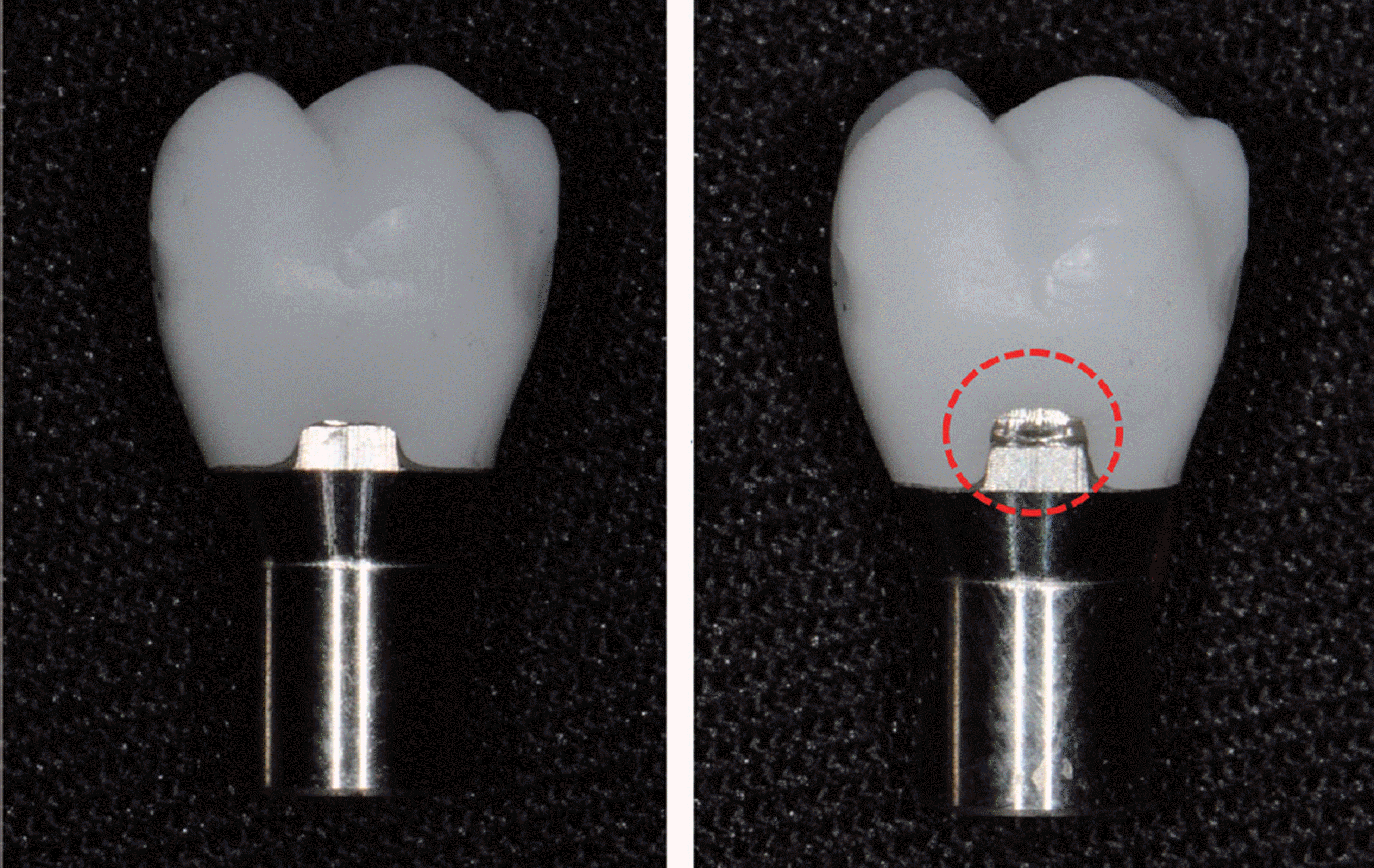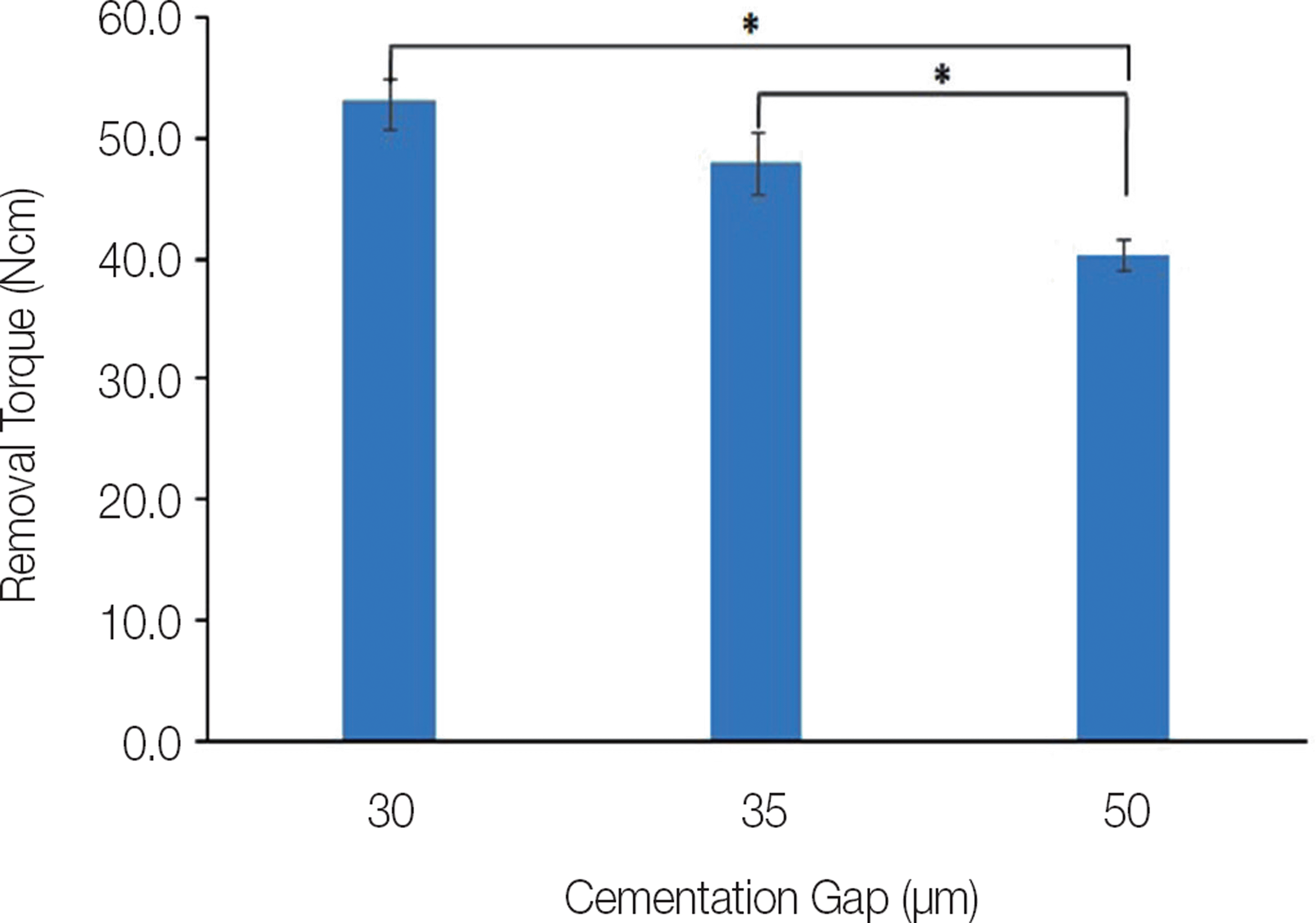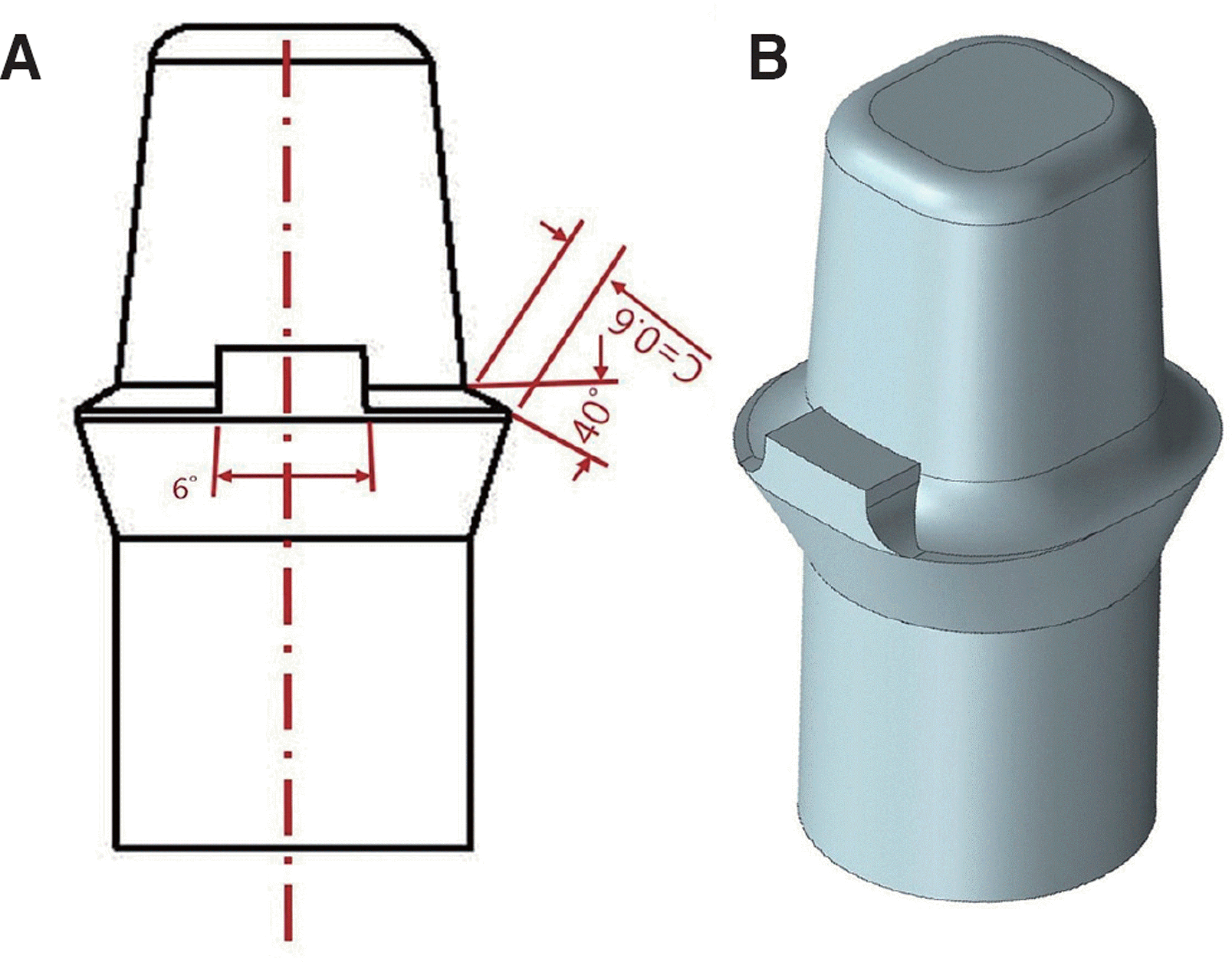Abstract
Purpose
Recently, a method of forming a slot in the prosthesis lingual has been introduced to solve the occlusal and aesthetic disadvantages of screw-retained prosthesis in the manufacture of implant-fixed prosthesis and to ensure retrievability in cement retained prostheses. The purpose of this study is to investigate the effect of the internal gap on the removal of the prosthesis in the preparation of cement-retained implant prostheses with lingual slots.
Materials and methods
Titanium abutment and internal gap of the zirconia prosthesis to be attached to the upper part were set to 30, 35, and 50 µm, respectively. Three for each type total 15 were produced for each type. The zirconia prosthesis formed a retrievable cement-type slot with a space of 1 mm at the location where the titanium abutment meets the shelf area. Autocatalytic resin cement was used for bonding of abutment and zirconia prosthesis, and the maximum removal stress value was measured in units of Ncm by using the customized equipment of the cemented specimen. The Kruskal-Wallis test was used to compare the three groups by statistical analysis (α = .05), modified by post hoc test the Mann-Whitney U-test and the Bonferroni correction method were used to compare the two methods (α = .017).
Go to : 
REFERENCES
1.Jarman JM., Hamalian T., Randi AP. Comparing the fracture resistance of alternatively engineered zirconia abutments with original equipment manufactured abutments with different implant connection designs. Int J Oral Maxillofac Implants. 2017. 32:992–1000.

2.Lee KB. Considerations of occlusion for implant-supported flxed prostheses. J Korean Dent Assoc. 2013. 51:242–9.
3.Hebel KS., Gajjar RC. Cement-retained versus screw-retained implant restorations: achieving optimal occlusion and esthetics in implant dentistry. J Prosthet Dent. 1997. 77:28–35.

4.Chee W., Felton DA., Johnson PF., Sullivan DY. Cemented versus screw-retained implant prostheses: which is better? Int J Oral Maxillofac Implants. 1999. 14:137–41.
5.Chung CH., Son MK., Kim SG. Clinical evaluation of retained preload and cement washout in screw- and cement-retained implant prosthesis. J Korean Acad Prosthodont. 2015. 53:301–9.

6.Chaar MS., Att W., Strub JR. Prosthetic outcome of cement-retained implant-supported fixed dental restorations: a systematic review. J Oral Rehabil. 2011. 38:697–711.

7.Chung CH., Son MK. The classification and comparison of implant prosthesis according to types of retention. Part I: screw retained prosthesis vs cement retained prosthesis. Implantology. 2010. 14:138–51.
8.Chung CH., Son MK. The classification and comparison of implant prosthesis according to types of retention. Part II: screw-cement retained prosthesis. Implantology. 2011. 15:58–70.
9.Prestpino V., Ingber A., Kravitz J., Whitehead GM. A practical approach for retrieving cement-retained, implant-supported restorations. Quintessence Dent Technol. 2001. 24:182–7.
10.Schweitzer DM., Berg RW., Mancia GO. A technique for retrieval of cement-retained implant-supported prostheses. J Prosthet Dent. 2011. 106:134–8.

11.Eames WB., O'Neal SJ., Monteiro J., Miller C., Roan JD Jr., Cohen KS. Techniques to improve the seating of castings. J Am Dent Assoc. 1978. 96:432–7.

12.Dixon DL., Breeding LC., Lilly KR. Use of luting agents with an implant system: Part II. J Prosthet Dent. 1992. 68:885–90.

13.Vermilyea SG., Kuf‡er MJ., Huget EF. The effects of die relief agent on the retention of full coverage castings. J Prosthet Dent. 1983. 50:207–10.

14.Hembree JH Jr., Cooper EW Jr. Effect of die relief on retention of cast crowns and inlays. Oper Dent. 1979. 4:104–7.
15.Breeding LC., Dixon DL., Bogacki MT., Tietge JD. Use of luting agents with an implant system: Part I. J Prosthet Dent. 1992. 68:737–41.

16.Heinemann F., Mundt T., Biffar R. Retrospective evaluation of temporary cemented, tooth and implant supported flxed partial dentures. J Craniomaxillofac Surg. 2006. 34:86–90.
17.Pan YH., Lin CK. The effect of luting agents on the retention of dental implant-supported crowns. Chang Gung Med J. 2005. 28:403–10.
18.Harder S., Dimaczek B., Açil Y., Terheyden H., Freitag-Wolf S., Kern M. Molecular leakage at implant-abutment connection—in vitro investigation of tightness of internal conical implant-abutment connections against endotoxin penetration. Clin Oral Investig. 2010. 14:427–32.

19.Kyrios DM., Duke ES., Windeler AS. Glass-ionomer cement film thickness and working time. J Prosthet Dent. 1989. 62:533–6.

20.Hembree JH Jr., George TA., Hembree ME. Film thickness of cements beneath complete crowns. J Prosthet Dent. 1978. 39:533–5.

21.Mehl C., Harder S., Steiner M., Vollrath O., Kern M. In‡uence of cement fllm thickness on the retention of implant-retained crowns. J Prosthodont. 2013. 22:618–25.
Go to : 
 | Fig. 3.Specimens before (left) and after (right) the fabrication of retrievable cement-type slot. |
 | Fig. 5.Removal torque values according to internal gap: Character ∗ indicates significant difference by Mann-Whitney U-test at α = 0.017. |




 PDF
PDF ePub
ePub Citation
Citation Print
Print





 XML Download
XML Download